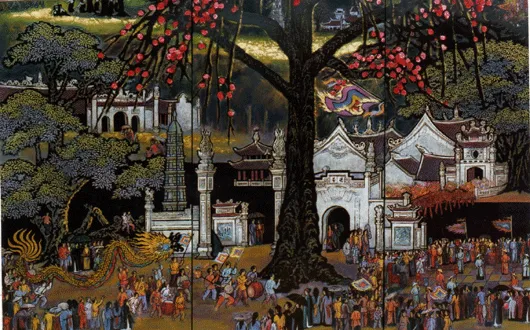Culture Watch: Lacquer - magical layers of colour

Lacquer was first used as people wanted to keep their wooden household items from cracking or being damaged by the weather. Then artisans began to use it as a material to decorate with.
The process of making a lacquer product is complicated and includes various steps. The first and one of the most important steps is making the board. A smooth board helps the lacquer to stick more firmly to its surface, ensuring its durability and shininess.
"I have to choose a type of sandpaper suitable for each type of board and then rub the board until it arrives at a proper flatness." - Ta Hung Cuong, Lacquer Artisan.
"In order to make a board, about 30 layers of lacquer need to be applied. After applying each layer of lacquer, we have to rub the board again. This step is very important to get a good, durable, flat and smooth board. Therefore, this step requires professional skill." - Nguyen Van Bang, Painter.
After rubbing the board, an artisan needs to follow other steps such as attaching cotton cloth onto both sides of the board, or coating the board with a mixture of alluvium and lacquer. To an experienced artisan, only by hearing the sound of the brush touching the board can he know whether it has reached a proper thickness. The next step is to cover the board with lacquer and rub it. This step takes a long time because the artisan has to do it several times.
Besides the complicated techniques and process, materials also contribute to adding more artistic value to lacquer artworks. The most important material is lacquer. Although there are many types of imported and industrial lacquers to choose from, Vietnamese traditional lacquer is preferred due to its advantages.
"Lacquer is extracted from the “sơn” tree (scientific name: Rhus Succedanea) in Phu Tho. It is very durable." - Ta Hung Cuong, Lacquer Artisan.
"Vietnamese traditional lacquer is soft. Meanwhile industrial lacquer is hard and therefore products using industrial lacquers are less beautiful. Vietnamese lacquer also makes the product look more three-dimensional." - Tran Dinh Binh, Painter.
"It is stickier so people can easily attach pearl, egg and snail shell, gold, silver, even bamboo and other materials." - Nguyen Van Bang, Painter.
Artisans and painters combine various types of material to create unique and beautiful artworks.
"Gold and silver create a special beauty for lacquer artworks because it makes them look shiny and brings an impressive visual effect." - Nguyen Van Bang, Painter.
Lacquer is applied in different fields from household items and decorations to painting. No matter what it is, each lacquer product shows a sophisticated, classical and dimensional beauty. Therefore, it has attracted many people.
"I think they look absolutely beautiful and I’m interested to read when the tradition of lacquer started. I think they look very decorative and professional and very tasteful, very nice. I like it a lot." - Tourist from Australia
"Lacquer painting requires skill and is time-consuming. Not everyone can do it even though they want to, because they are not patient enough. If they are not patient, they cannot follow this art." - Tran Dinh Binh, Painter.
With sophisticated techniques, a complicated process, a variety of materials and the skillful hands of artisans, the art of lacquer brings us numerous magical layers of colour.
Tags:





